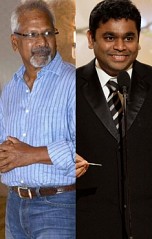PHOTOS & STILLS - GALLERY

THE MAN + THE MAKER PART 2
“I think [mainstream cinema] can have all the sensibility of so-called serious cinema & still remain connected to a large audience”
I have analyzed Mani Ratnam movies as though I were doing a Masters in Madras Talkies. Although I am too young to have seen most of his earlier films in their moment, even while watching them now I can plainly tell that the man began a revolution. His filmmaking style was a fresh take on Tamil cinema – it stood above a sea of lookalikes, yet somehow balanced in between mainstream & independent films.
In his biography Baradwaj explains that ‘no one understood his generation like Mani did’, & it’s this understanding that allowed him to craft stories that audiences couldn’t help but become obsessed with. Mani admits that in his first real hit Mouna Ragam he had not originally included Karthik’s character, but later added in the ‘lost love’ element because he felt the Indian masses would not reconcile with the idea of a young, suitable female not wanting to get married for no particular reason. His understanding of his audience, as well as his formula for equal parts masala & drama has allowed him to find a place in between commercial directors who capture you just for the moment and those who feel that ‘serious-musicals’ are an oxymoron altogether. In fact, if anyone understands the power of music in a film, it’s Mani.
“[A song] is not a compulsion that is thrust on you, but a special card that you hold in your hand”
Many fans might not be aware that Roja’s soundtrack is on Time World’s 10 Best Soundtracks list & that Bombay is the top selling Indian music album of all time. Of course this acclaim is attributable to Madras’ Maestro AR Rahman, but Ratnam’s explanation that getting the right music for a film largely depends on how well you brief your composer makes it clear that his superior storytelling & direction inspired. He recognized that, if used correctly, music helps “make a narrative believable” and breaking into song did not have to erase the impact of a moment – nor did a song video immediately mean transporting to a foreign land irrelevant to the story. When the music demanded extravagance (Guru) he gave it to us in the form of beautiful costumes & just the right number of background dancers to envelop us in grandeur. But married life while being poor in the city also suddenly became extremely desirable with the way Mani captured minimalistic love in “Sandhai Kozhi” (Ayaithu Ezhuthu) & “Kathal Sadugudu” (Alaiypayuthey). He has become famous for mastering opulence and simplicity all at once. This style, along with his romantic symbolism & ability to bring forth powerful ideals through commercial cinema are exactly how he altered the profile of South Indian cinema.
What’s a Mani movie without some rain & a few mirrors? Through his iconic use of such reoccurring & stylized imagery Tamil audiences everywhere have come to associate dancing in the rain with falling in love. And, through practically all his films, we have become convinced that public transportation – what Ratnam explains as symbolic of Chennai youth’s desire for independence – are the top locations for all of life’s most heartwarming & dramatic moments.
“It’s not a platform on which you debate ideological issues, beyond what the characters can realistically say”
Like his symbolism, it’s not hard to notice that Mani tends to echo some themes, but his fresh storylines erase all signs of repetition. From diverse viewpoints Mani often tells us about brave women (Roja, Kannathil Muthamittal) & of moving from the ‘minor leagues’ into the big time (Guru, Kadal, Nayagan), through honorable & illicit means. Scattered amongst his filmography is a wealth of socio-political proclamations (usually not his personal ones) on war, terrorism, corruption, women’s rights & the caste system; we often just didn’t notice their weight, or that we were being informed, until after the credits rolled, because we were lost in his description.
Mani sir has taught me so much, and he doesn’t even know it. Thanks to the realism in his films I have learned that love doesn’t have to be at first sight (Geetanjali), and that a guy can fall for a girl’s intelligence & ability to challenge his heroism; that chasing your dreams is completely justifiable if you want to leave a mark on this world; and that there’s beauty in everyday locations (like train stations).
Although he has not been in the favor of the box office as of late he has consistently received praise from most critics for his bravery to try new things & continue inventing himself. From embracing new technology, like using live sound in Ayaithu Ezhuthu, to pioneering the craft of using children in significant roles to narrate serious situations (Anjali, Kannathil Muthamittal). His openness to debutante stars & fresh talent for his crew are part of the reason why he continues to grow & I have faith that his innovation will coincide with what the box office is looking for again soon.
He put Tamil cinema on the global map with his realistic plots, eye for new talent, humility, leadership ability & quintessentially Mani-style of symbolism & imagery, and when you look at him as a whole – as a person & a creator of moving art – you can’t help but be captivated.
It may be his birthday, but I make the wish, to one day meet him & ask him myself if he’s aware of the impact he has had on the course of Indian film history. I suspect that, even in my dream scenario, he would humbly withdraw from the deepness of my inquiry. But I also suspect that, should my wish ever come true, realistically I would be utterly speechless & unable to ask him anything – awestruck to be in the presence of a cinematic legend & my all time favorite director.
This piece was a continuation of “The Man + The Maker – Part 1” posted on Wednesday June 5th 2013.
Behindwoods is not responsible for the views of columnists.
FACEBOOK COMMENTS
OTHER LATEST COLUMNS
DILANI RABINDRAN'S OTHER COLUMNS
- The Rahmaniac Syllabus
- Do you know who Rajinikanth is?
- Ajith - Making Bad look so Good
- Raja Rani and the Cinematic Couples Therapy
- Behindwoods at TIFF - Days 8 -11
- Behindwoods at TIFF – Days 5 to 7
- Behindwoods at TIFF – Days 1 – 4
- Will he or won't he - Vijay and the guessing game
- "A Gun & A Ring" and a Director to Watch For
- Thala - Using his status to lead !
- Rapid Fire with Vidyu Raman
- "Funny Girl" – An Interview with Vidyu Raman
- The Man & The Maker (Part 1)
- "Festivals of Film &Globalization"
- "Using Film for Societal Change"
- 15 Years of Jeans
- "How the South Shapes Bollywood"
- "A Marriage of Film and TV"
- Women in Real and Reel Life
- Hitting the Jackpot Twice
- VISHWAROOPAM: A Lesson in Crisis Communications
- "Education Through the Silver Screen"
- From Maddy to Gautham - The Valentine's Day Spread
- Vishwaroopam: A first hand account from across Atlantic!
RELATED LINKS
- The very best of Tamil cinema, 2013 - A comprehensive analysis
- Conversations with Mani Ratnam - Baradwaj Rangan
- Shraddha Das I II III IV V VI VII VIII IX X XI XII XIII XIV XV XVI XVII XVIII XIX XX
- 15. Anjali | Top 20 Actresses in Tamil - Slideshow
- CIFF Red Carpet Day 6
- CIFF Red Carpet Day 4
- Shanmugapandian I II
- Mani Ratnam and Jyothika at Art Supports Medicine
- Mani Ratnam And Jyothika at Art Supports Medicine
- Ganguly at Apollo Munich Health Insurance
- Shweta & Anjali - the case of hope and despair!
- 2002 | Must Own Albums of the New Millennium - Slideshow
- Mani Ratnam - Nandhan | Million Dollar Babies - The Star Kids - Slideshow
- Madha Gaja Raja Movie Preview
- Vishal sings My Dear Loveru for Madha Gaja Raja











